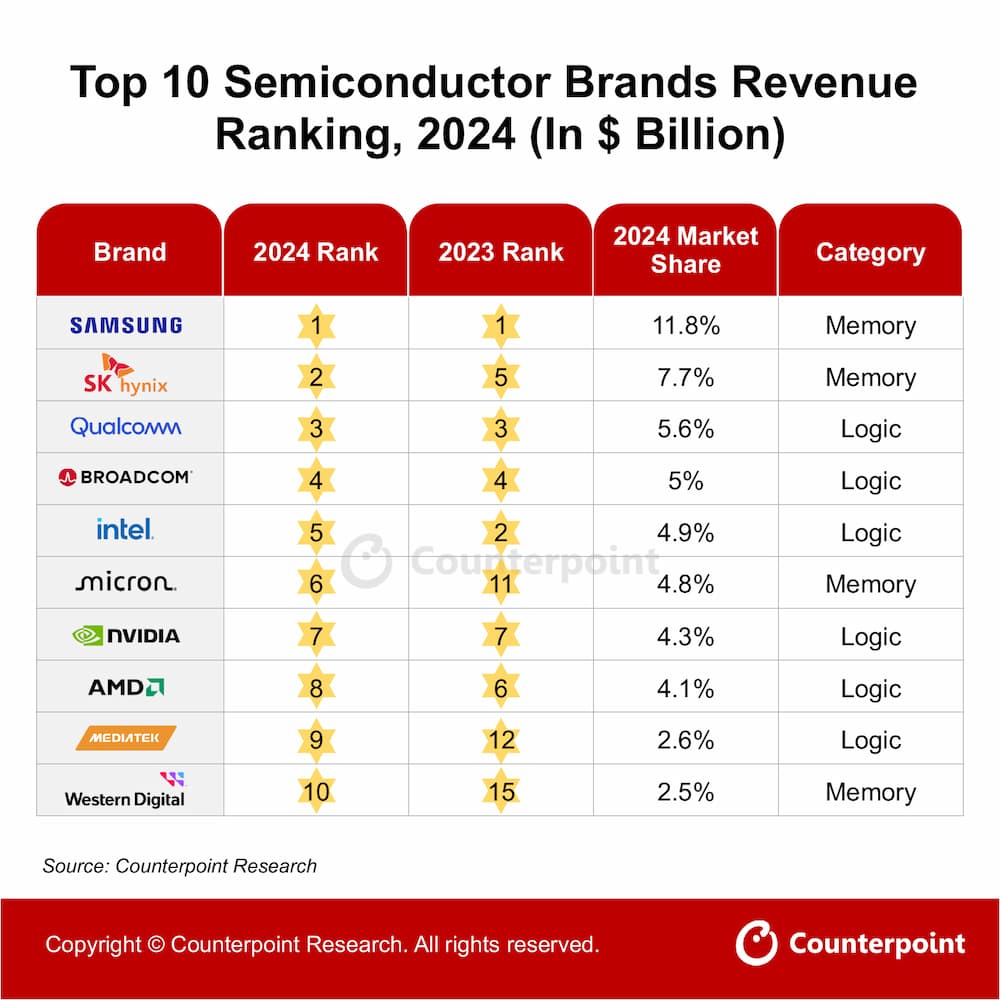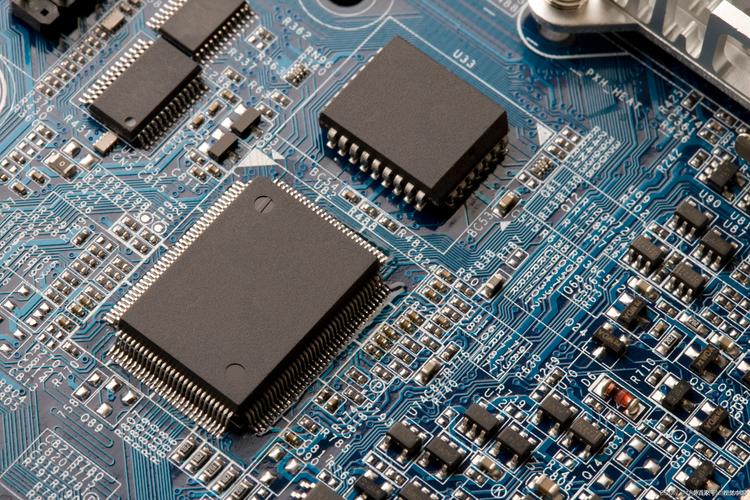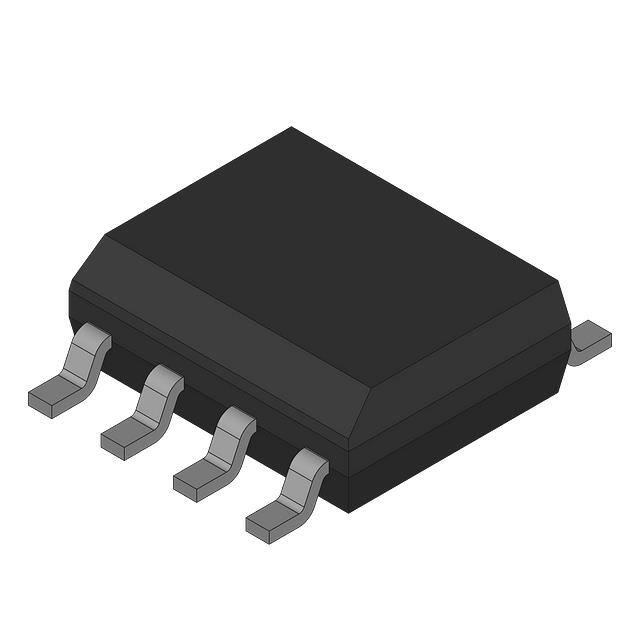In 2024, the global semiconductor market revenue increased by 19%, and the pattern of the top 10 manufacturers changed
According to the latest report from market research firm Counterpoint, the global semiconductor market (including the storage industry) revenue is expected to increase by 19% year-on-year in 2024, reaching US$621 billion. This growth trend indicates that the semiconductor industry is recovering strongly after a period of adjustment driven by emerging technologies, and the performance and competition of major manufacturers in the market also present a complex and subtle new pattern.

Manufacturer performance
Samsung Electronics: Ranked first in the world with a market share of 11.8%. Samsung's advantage is due to many factors: the memory chip market will see a recovery in demand and prices in 2024, and Samsung, as a giant in the memory field, will directly benefit from this; inventory adjustments and replenishment in the smartphone business will bring it a stable income stream; in addition, Samsung actively attracts AI/HPC (artificial intelligence/high-performance computing) customers to introduce advanced processes, further consolidating its technological leadership and enhancing its competitiveness in the high-end market. Despite challenges such as HBM3e latency and low-end memory, Samsung still dominates the global semiconductor market with its strong comprehensive strength.
SK Hynix: Ranked second with a market share of 7.7%. Its excellent performance in 2024 is mainly attributed to the good market conditions in the memory chip market and the strong demand for HBM (high-bandwidth memory) in AI applications. With the rapid development of AI technology, the market demand for HBM has exploded. SK Hynix seized the opportunity and continued to invest in R&D and production in the HBM field to improve product performance and production capacity, thereby standing out in the market competition and achieving a significant increase in market share, jumping from fifth place in 2023 to second.
Qualcomm: Ranked third with a market share of 5.6%, with sales increasing by 14% year-on-year. Qualcomm's growth is due to the recovery of the Android smartphone market and the steady growth of its automotive business. In the field of smartphones, as the Android phone market gradually picks up, the demand for Qualcomm's chip products has increased; at the same time, Qualcomm has actively deployed in the automotive chip market, providing advanced chip solutions for automakers, and has gained a certain market share in the fields of smart driving and car networking. However, Qualcomm's recovery in the IoT (Internet of Things) market is relatively slow, which has also limited the expansion speed of its overall business to a certain extent.
Broadcom: Ranked fourth with a market share of 5%. Broadcom has obvious chip technology advantages in the field of communications, and its products are widely used in network communications, data centers and other fields. With its stable performance in these key fields, Broadcom has maintained a stable market share.
Intel: Fell to fifth with a market share of 4.9%. Intel's traditional business has been hit by weak demand in the PC and server markets. At the same time, Intel encountered bottlenecks in process technology upgrades. Compared with its competitors, it is at a disadvantage in the production of advanced process chips, which has led to intensified market competition pressure and its market ranking has fallen from its previous high to fifth.
Micron: Ranked sixth with a market share of 4.8%. Micron mainly benefits from the prosperity of the storage chip market and AI's demand for HBM. It continues to invest in storage technology research and development and production, optimizes product performance and cost structure, and has strong market competitiveness in storage products such as solid-state drives (SSDs) and DRAM, thus occupying an important position in the global semiconductor market.
Nvidia: Ranked seventh with a market share of 4.3%. Nvidia has an important position in the GPU field, and its products play a key role in AI model training and development, driving the growth of the global logic semiconductor market.
AMD: Ranked eighth with a market share of 4.1%. AMD is also constantly making efforts to gradually narrow the gap with Nvidia by launching high-performance GPU and CPU products, and has achieved a certain share growth in the data center, game and other markets.
MediaTek: Ranked ninth with a market share of 2.6%. MediaTek is active in the field of consumer electronics chips, especially in the smartphone chip and IoT chip markets, and meets the needs of the mid- and low-end markets by providing cost-effective products.
Western Digital: Ranked tenth with a market share of 2.5%. Western Digital has a deep technical accumulation and market foundation in the field of storage devices, and its storage products such as hard drives and flash memory have a wide user base in the global market.
It should be noted that this statistics only covers semiconductor companies with their own brands, and does not include foundry suppliers (such as TSMC and UMC).
Market Analysis
The strong growth in 2024 is mainly due to the substantial increase in demand for artificial intelligence (AI) technology, especially the continued promotion of memory market and GPU demand.
Counterpoint believes that the United States remains the core of the global semiconductor industry, with many high-value semiconductor companies, and plays a key role in promoting global innovation and market growth. As the demand for AI and high-performance computing continues to grow, US semiconductor leaders will continue to play a pivotal role in future market competition.
In addition, the memory chip market performed particularly well. In 2024, the global memory chip market revenue is expected to increase by 64% year-on-year, mainly driven by the recovery of demand and price increases. In addition, driven by AI demand, the booming high-bandwidth memory (HBM) market has further supported the overall memory chip market.
In the logic semiconductor market, the key role of GPU in AI model training and development has led to an expected 11% year-on-year growth in the global logic semiconductor market. Despite the weak demand in the automotive and industrial markets, there is still a partial recovery trend, which will help the global semiconductor industry revenue growth. In addition, the popularization of chiplet technology is expected to further lower the threshold for AI chip design and promote industry innovation.

Focus of competition: technological commanding heights and ecological game
▶ The HBM competition among storage giants
Samsung, SK Hynix and Micron are competing to advance the development of HBM3e and HBM4 to compete for AI server market share. Samsung tried to make up for the disadvantage of delayed mass production by optimizing the 12-layer stacked HBM3e technology; SK Hynix took the first-mover advantage by virtue of its early cooperation with Nvidia.
▶ The battle between customization and standardization of AI chips
Nvidia builds a moat through the CUDA ecosystem, while Broadcom and AMD focus on the customized AI accelerator market. At the same time, the penetration rate of Arm's Neoverse architecture in data centers has increased, driving companies such as Qualcomm and MediaTek to accelerate the layout of AI chips.
▶ Supply chain reconstruction under geopolitics
The US technology control on China has prompted manufacturers such as Samsung and SK Hynix to adjust their production capacity layout in China. For example, Samsung's Dalian factory has expanded its investment in advanced processes to balance geopolitical risks and market demand.


